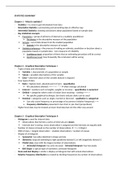Summary
Summary of Statistics | Managerial Statistics, Keller | RSM premaster
- Course
- Institution
- Book
This document summarizes Chapters 1 through 4 and 6 through 12 from Keller's Managerial Statistics book (2014). The summary contains all the theory you need to know before the Statistics exam. Statistics is part of the premaster, RSM Erasmus University. The summary is in English.
[Show more]




